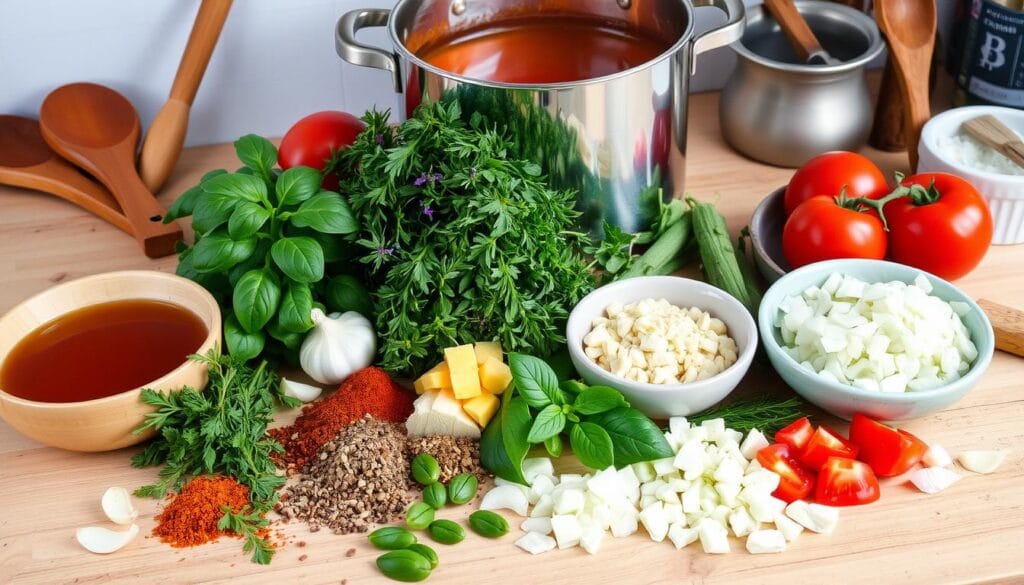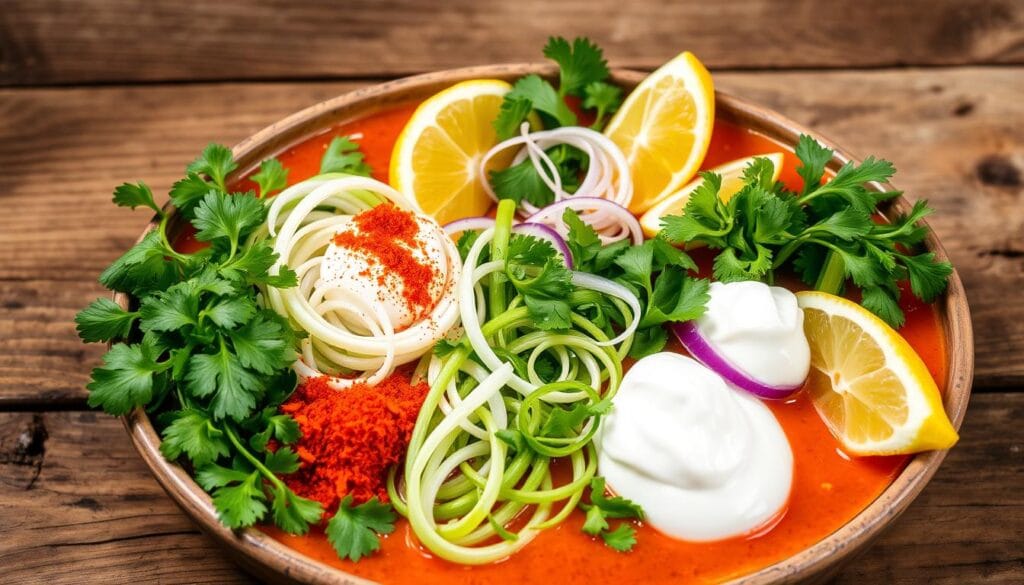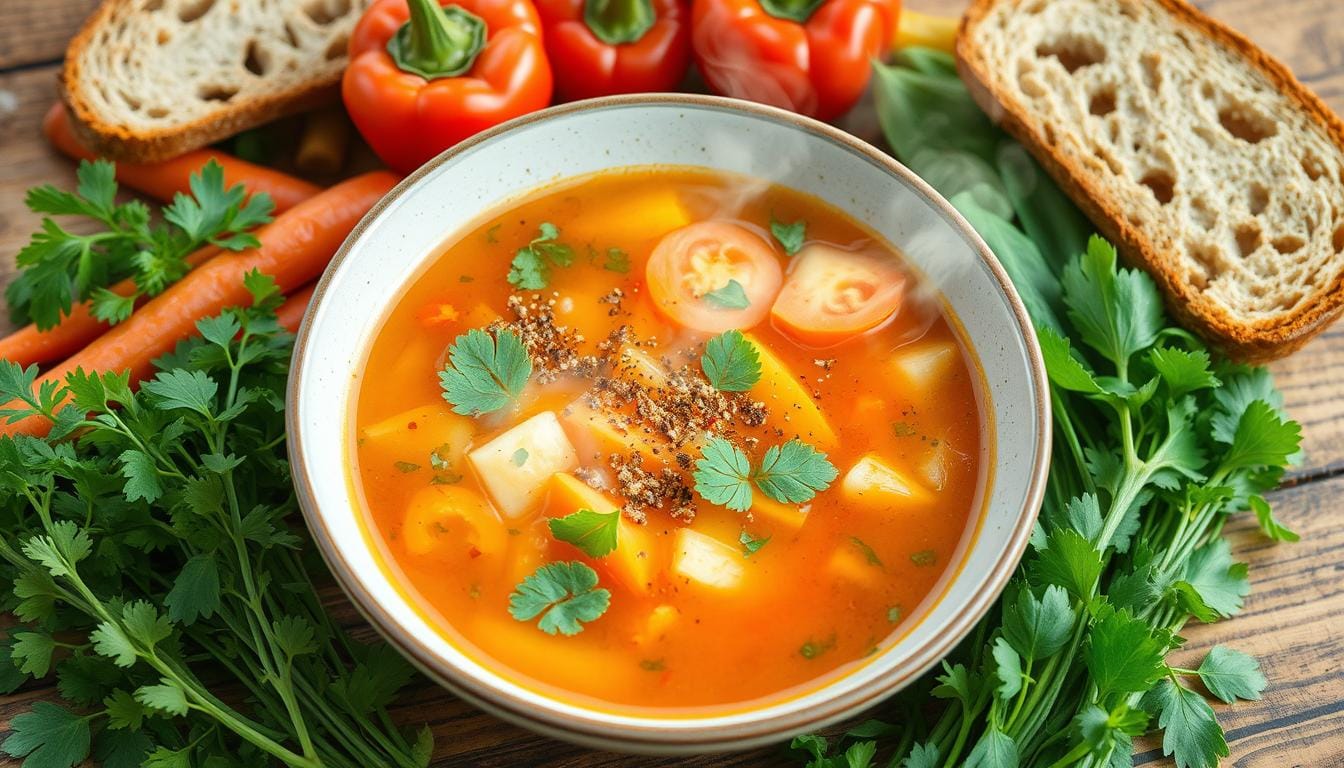As the aroma of simmering homemade soup fills your kitchen, you feel comfort and satisfaction. Ever wondered how to make your soup even better? Elevating homemade soup’s flavor is an art. Today, I’ll share simple tips to make your soup exceptional. These simple tips to make homemade soup more flavorful will help you create soups that are full of depth and taste.
Homemade soup is like a canvas, waiting for delicious flavors. Use fresh herbs, quality ingredients, and smart seasoning. This way, you’ll make soups that everyone will love. Get ready to make your homemade soup creations shine and become the soup-making master in your kitchen.
Understanding the Foundation: Simple Tips for Making Flavorful Homemade Soup
Making a delicious soup starts with knowing the basics of flavor. Every great soup has a mix of salt, fat, acid, and heat. These are the building blocks of taste, as chef Samin Nosrat teaches.
The Four Elements of Taste for Flavorful Homemade Soup: Salt, Fat, Acid, and Heat
Salt brings out the natural tastes of your ingredients. Fat makes the soup rich and smooth. Acid, like lemon or vinegar, brightens the soup and balances it. Heat blends the flavors together, making them more complex.
Importance of Quality Ingredients
Choosing the best ingredients is key for a great soup. Use fresh, seasonal produce and top-notch proteins. A homemade soup base adds depth of flavor. Better ingredients mean a more vibrant and satisfying soup.
Building Layers of Flavor
To make your soup stand out, focus on layering flavors. Start by browning meats for a rich base. Then, cook aromatic veggies like onions and garlic to release their oils and smells.
As you add more flavors, think about using a parmesan cheese rind or a bit of acid. This adds umami and balances the taste. By using these cooking techniques, you’ll make soups that are not just tasty but also nourishing.
How to Make Homemade Soup More Flavorful?
Making your homemade soup more flavorful is simpler than you think. A few easy techniques can turn a basic soup into a cozy, satisfying meal. Here are some tips to enhance your soup’s taste.
Start with a Robust Broth
A great soup starts with a flavorful broth or stock. Choose a rich, aromatic broth, whether homemade or store-bought. Making your own broth lets you pick the ingredients for the best flavor.
Incorporate Umami-Packed Ingredients
Look for ingredients with a strong umami taste. Parmesan cheese rinds, soy sauce, or anchovies are great. They add a deep, savory flavor to your soup.
Layer Flavors as You Cook
- Start with aromatics like onions, carrots, and celery. Then add heartier veggies later.
- Use wine, broth, or vinegar to deglaze the pot. This captures all the tasty bits stuck to the bottom.
- Season as you go, adjusting the flavors to get the perfect taste.
Finish with a Flavor Boost
Before serving, add a splash of lemon juice or vinegar. It brightens the flavors. Fresh herbs, grated Parmesan, or olive oil can also enhance your soup’s taste and look.
Follow these tips to make soups that are full of flavor. Your family and friends will love them.
Simple Tips to Create the Perfect Soup Base for More Flavorful Homemade Soup
Making a great soup starts with the base. Homemade soup stock beats store-bought in flavor. It’s made by simmering bones, veggies, and herbs, adding depth you can’t find elsewhere.
Enhance Soup Flavor: Homemade Stock vs Store-Bought Broth
Homemade soup stock tastes better and is of higher quality than store-bought. The slow simmer thickens the broth with gelatin from bones, making it richer. You also control the aromatics and seasonings, tailoring the flavor to your liking.
Essential Aromatics and Their Role
- Onions, carrots, and celery – the classic “mirepoix” – form the foundation of many flavorful soups.
- Garlic adds a savory depth and complexity to the broth.
- Fresh herbs like parsley, thyme, and bay leaves impart their unique aromas and flavors.
Proper Seasoning Techniques
Seasoning your soup is an art. Start with a little seasoning and taste as you go. This lets you build flavors gradually, ensuring a balanced taste. Try mixing dried and fresh herbs for a richer flavor.
| Seasoning Ingredient | Flavor Profile |
|---|---|
| Paprika | Sweet and rich |
| Cumin | Warm and earthy |
| Turmeric | Anti-inflammatory and golden hue |
Learning to make a flavorful soup base is key to making soups that are truly satisfying and delicious.
The Art of Cooking Vegetables for Soup
Getting your vegetables ready is key to making tasty homemade soups. It’s important to cut them into the same size so they cook evenly. Put in the bigger veggies like potatoes first, and add the softer greens like spinach last.
Using both fresh and frozen veggies can make your soup better. Roasting your veggies before adding them can also make them taste richer. It brings out their natural sweetness and smell.
Ideal Vegetable Preparation for Soup
- Cut vegetables into evenly-sized pieces for uniform cooking
- Add heartier vegetables like potatoes, carrots, and onions earlier in the process
- Incorporate more delicate greens, such as spinach or kale, towards the end of cooking
- Experiment with a mix of fresh and frozen vegetables to suit your needs
- Roast vegetables before adding them to the soup to enhance their flavor
| Vegetable | Preparation | Cooking Time |
|---|---|---|
| Potatoes | Diced | 20-25 minutes |
| Carrots | Sliced or diced | 15-20 minutes |
| Onions | Diced | 10-15 minutes |
| Spinach | Chopped | 5 minutes |
Think about how you prepare and cook your veggies. This way, you can mix different textures and tastes. It will make your homemade soup even better.
“Soup is a lot like a family. Each ingredient enhances the others; each batch has its own unique character; and it needs time to simmer to reach full flavor.”
– Marge Kennedy
Strategic Use of Herbs and Spices
Using herbs and spices wisely can greatly enhance homemade soups. Fresh herbs like parsley, thyme, rosemary, and bay leaves add a lively, aromatic flavor. Dried seasonings, on the other hand, bring a deeper, richer taste.
Fresh vs. Dried Herbs
Fresh herbs should be added near the end of cooking to keep their flavor. They add a bright, fresh taste to your soup. Dried herbs, however, release their flavors slowly. They’re best added early to infuse the dish fully.
Timing Your Seasoning
- Add dried herbs and spices early in cooking to let their flavors blend with other ingredients.
- Introduce fresh herbs just a few minutes before serving to keep their aroma and taste.
- Try different herb and spice mixes to find the perfect balance for your taste.
Knowing how to use fresh and dried herbs and when to add them can take your soups to the next level. Use these flavorful elements to make your dishes stand out.
Powerful Ingredients to Enhance Homemade Soup Flavor
Improving your homemade soup’s flavor is easy. A few secret ingredients can make a big difference. Parmesan rinds and fish sauce are just a couple of these hidden gems. They can turn a simple broth into a flavorful masterpiece.
Parmesan rinds are a great addition to soup. As the cheese ages, its rind gets very umami. Just add it to your pot while it’s simmering, and let the flavors mix.
Adding a bit of wine or fresh lemon juice can also enhance your soup. The acidity balances the flavors, making the soup feel lighter and more refreshing.
- A teaspoon of fish sauce adds savory, umami notes to your soup.
- Miso paste gives a complex, fermented flavor to your broth.
- Kombu seaweed adds a subtle, umami-rich taste.
- Soy sauce or tamari adds a salty, umami kick.
Feel free to try these secret ingredients. Start with a little, taste, and adjust as needed. This way, you’ll find the perfect mix of flavor enhancers, umami, and secret ingredients to make your soup amazing.
“The secret to great soup lies in the layers of flavor you build, one ingredient at a time.”

| Ingredient | Flavor Contribution | Recommended Ratio |
|---|---|---|
| Parmesan Rind | Umami, Saltiness, Aged Flavor | 1 (2-inch) piece per 6 cups broth |
| Fish Sauce | Savory, Umami | 1 teaspoon per 6 cups broth |
| Miso Paste | Complex, Fermented Flavor | 1 tablespoon per 6 cups broth |
| Kombu Seaweed | Subtle, Umami-Rich | 1 (2-inch) piece per 6 cups broth |
| Soy Sauce/Tamari | Salty, Umami | 1-2 tablespoons per 6 cups broth |
Mastering the Cooking Time and Temperature
Creating delicious homemade soups requires careful attention to cooking time and temperature. The secret to rich flavors is simmering, not boiling.
Simmering vs. Boiling
Simmering is key for a balanced soup. Keep the pot at a gentle simmer, not a full boil. This method lets flavors slowly release, avoiding the overcooking that boiling can cause.
When to Add Different Ingredients
- Start with aromatics: Begin by sautéing onions, garlic, and other fragrant vegetables to build the foundation of your soup’s flavor.
- Add broth and hearty vegetables: Once the aromatics have softened, pour in your broth or stock and add heartier vegetables like carrots, potatoes, or celery.
- Finish with delicate ingredients: Toward the end of the cooking time, stir in delicate ingredients like leafy greens, tender herbs, or proteins to prevent them from overcooking.
Give enough time for flavors to blend and grow. Slow, steady simmering over low heat is the secret to a flavorful homemade soup.
“Simmering is the secret to developing deep, complex flavors in homemade soup. Slow and steady is the way to go.”
| Cooking Technique | Temperature Range | Result |
|---|---|---|
| Simmering | 185°F to 205°F | Gentle, slow cooking that allows flavors to meld and develop |
| Boiling | 212°F | Rapid, high-heat cooking that can lead to overcooking and loss of delicate flavors |
Professional Tips for Soup Garnishing
Adding the right garnishes can transform your homemade soups. Professional chefs know that garnishes not only look great but also add texture and flavor. This is one of the simple tips to make homemade soup more flavorful, making your dish stand out.
Fresh herbs are a top choice for soup garnishes. A sprinkle of basil or thyme can brighten up any soup. For creamy soups, a swirl of pesto or herb oil adds a burst of flavor.
Crunchy elements like toasted nuts or croutons add a nice contrast to smooth soups. Chefs mix these to balance flavors and textures.
Adding a dollop of tangy yogurt or sour cream can enhance your soup’s flavor. It cools down the richness of the soup, offering a refreshing contrast.
There are many ways to garnish your soups. Try grated cheese, a drizzle of olive oil, or spicy paprika. These simple additions can make your homemade soups truly special.
| Garnish | Flavor and Texture Impact |
|---|---|
| Fresh Herbs | Adds fragrance, freshness, and a pop of color |
| Toasted Nuts and Seeds | Provides a crunchy contrast to the soup’s texture |
| Croutons | Adds a satisfying crunch and can soak up the soup’s flavors |
| Yogurt or Sour Cream | Offers a cool, creamy counterpoint to the soup’s richness |
| Grated Cheese | Provides a savory, umami-packed flavor boost |
| Olive Oil | Adds a luxurious mouthfeel and enhances the soup’s overall flavor |
Using these professional garnishes can take your homemade soups to the next level. They enhance both the look and taste, making your meal feel like a restaurant experience at home.

Storage and Reheating Techniques for Better Flavor
Storing and reheating your soup right can really boost its flavor. Keep it in airtight containers in the fridge for up to 4 days. Or, freeze it for up to 3 months.
When reheating, be careful not to overcook. Soups with beans or grains might thicken. So, you might need to add a bit more liquid to get the right consistency.
| Reheating Method | Time | Tips |
|---|---|---|
| Microwave | 2-3 minutes | Start with 2-3 minutes and adjust as needed, stirring intermittently to prevent hot and cold spots. |
| Stovetop | 5-10 minutes | Gently simmer the soup to meld the flavors, avoiding excessive boiling to prevent separation. |
| Steamer | 10-15 minutes | Heat the soup until it reaches 165°F, but be careful not to overfill the steamer pan with water. |
It’s best to reheat soup only once to avoid bacteria growth. If it curdles or separates, a gentle stir or quick blend can fix it.
By using these soup storage and reheating soup tips, you can enjoy your homemade leftovers many times.
Conclusion
Making tasty homemade soup requires careful thought, quality ingredients, and smart cooking methods. Simple tips to make homemade soup more flavorful include knowing how to mix flavors and season well, which can truly make your soup stand out. Try using fresh veggies, herbs, and spices to find your own unique soup style.
Being patient and giving soups time to develop their flavors is key. They often taste even better the day after, as all the ingredients blend together. This makes soups a great choice for meals you can prepare ahead of time.
Now you have the simple tips to make delicious homemade soups more flavorful. Be creative, trust your taste, and enjoy perfecting your soup-making techniques. Happy cooking!

